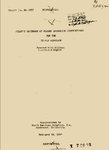wuzak
Captain
In 1939 the USAAC was looking for new aircraft which would provide a quantum leap in performance over existing types.
In order to get this aircraft in production as quickly as possible the standard process was abandoned in favour of a "streamlined" process called "Request for Data R40-C" (40 represening Fiscal Year 1940).
The goals were high. Initially a top speed of 525mph was requested, but this was later revised down to 450mph and then 425mph (remember the P-38, P-39 and P-40 hadn't yet made production, none of which could match that performance). It was to be a single engine, single seat fighter with heavy aarmament, which could include anything from the .30 LMG to the 37mm cannon. Unconventional layouts would not be looked upon unfavourably.
The choice of engine included those under development at the time, and included: the Allison V-1710 V-3420, Continental IV-1430, Wright R-2160 Tornado, Pratt Whitney X-1800 and R-2800 and the Lycoming O-1230/H-2470 (not sure when the latter began).
It was expected that the prototype would be built and tested during FY41, with production coming on line in FY42 (ie by June 1942).
Historically 3 types were selected for further development, 3 of them flying. Vultee had the XP-54, Curtiss the XP-55 and Northrop the XP-55. The XP-55 was to use the IV-1430 and the others the X-1800. The XP-55 ended up with the V-1710, the Xp-54 the H-2470 and the XP-56 with an R-2800.
All three were pusher aircraft, of different configurations - the Vultee was a twin boom aircraft, the Curtiss a tail first design and the Northrop a flying wing.
http://www.fantastic-plastic.com/VulteeXP-54AnigrandPhoto.jpg
http://www.aviastar.org/pictures/usa/vultee_xp-54.gif
http://farm4.static.flickr.com/3199/4555977591_8eed842e62.jpg
http://kikakuya.files.wordpress.com/2008/07/ascender.gif
http://jpcolliat.free.fr/north/images/xp-56_3.jpg
http://www.aviastar.org/pictures/usa/northrop_xp-56.gif
I believe that the Bell XP-52 and XP-59 also came from R40-C. McDonnell proposed its Type 1, which interested the USAAC sufficiently that a contract for development of the Type 2 (XP-67) was awarded.
So, what configuration, engine, etc, would you choose?
In order to get this aircraft in production as quickly as possible the standard process was abandoned in favour of a "streamlined" process called "Request for Data R40-C" (40 represening Fiscal Year 1940).
The goals were high. Initially a top speed of 525mph was requested, but this was later revised down to 450mph and then 425mph (remember the P-38, P-39 and P-40 hadn't yet made production, none of which could match that performance). It was to be a single engine, single seat fighter with heavy aarmament, which could include anything from the .30 LMG to the 37mm cannon. Unconventional layouts would not be looked upon unfavourably.
The choice of engine included those under development at the time, and included: the Allison V-1710 V-3420, Continental IV-1430, Wright R-2160 Tornado, Pratt Whitney X-1800 and R-2800 and the Lycoming O-1230/H-2470 (not sure when the latter began).
It was expected that the prototype would be built and tested during FY41, with production coming on line in FY42 (ie by June 1942).
Historically 3 types were selected for further development, 3 of them flying. Vultee had the XP-54, Curtiss the XP-55 and Northrop the XP-55. The XP-55 was to use the IV-1430 and the others the X-1800. The XP-55 ended up with the V-1710, the Xp-54 the H-2470 and the XP-56 with an R-2800.
All three were pusher aircraft, of different configurations - the Vultee was a twin boom aircraft, the Curtiss a tail first design and the Northrop a flying wing.
http://www.fantastic-plastic.com/VulteeXP-54AnigrandPhoto.jpg
http://www.aviastar.org/pictures/usa/vultee_xp-54.gif
http://farm4.static.flickr.com/3199/4555977591_8eed842e62.jpg
http://kikakuya.files.wordpress.com/2008/07/ascender.gif
http://jpcolliat.free.fr/north/images/xp-56_3.jpg
http://www.aviastar.org/pictures/usa/northrop_xp-56.gif
I believe that the Bell XP-52 and XP-59 also came from R40-C. McDonnell proposed its Type 1, which interested the USAAC sufficiently that a contract for development of the Type 2 (XP-67) was awarded.
So, what configuration, engine, etc, would you choose?

